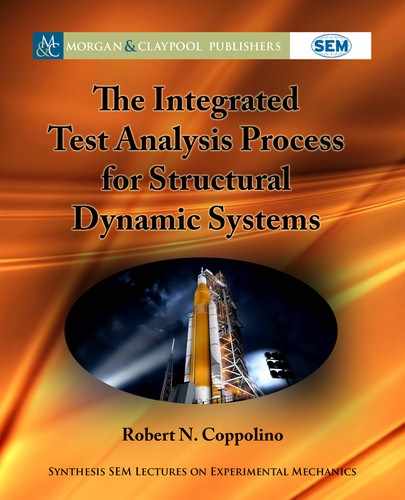108 6. SYSTEMATIC TEST ANALYSIS CORRELATION
Œ
ˆ
a
T
Œ
M
aa
Œ
R
Œ
0
: (6.4)
e modal coherence matrix, ŒCOH, is defined based on manipulation of Equation (
6.1)
(taking into account the results stated in Equations (6.2)–(6.4)) resulting in
Œ
COH
D
Œ
I
Œ
OR
t
1=2
R
T
MR
Œ
OR
t
1=2
D
Œ
OR
t
1=2
COR
t
OR
a
COR
Œ
OR
t
1=2
; (6.5)
where the test mode orthogonality matrix is
Œ
OR
t
D
ˆ
T
t
M
aa
ˆ
t
: (6.6)
e modal coherence matrix, ŒCOH, provides a metric of the ability of mathematical
model modes, Œˆ
a
, to reconstruct the measured modes, Œˆ
t
; in particular, if the diagonal term,
jCOH
nn
j, associated with measured mode “n” is unity, the measured mode is a perfect linear
combination of the mathematical model modes, Œˆ
a
.
Having already discussed U.S. government criteria for test mode orthogonality, it is in-
formative to note corresponding criteria for test-analysis correlation. NASA-STD-5002 [1]
states “Agreement between test and analysis natural frequencies shall, as a goal, be within 5%
for the significant modes (aka target modes)…Mode shape comparisons shall be required via
cross-orthogonality checks using the test modes Œˆ
t
, the analytical modes Œˆ
a
, and the ana-
lytical mass matrix ŒM
aa
. e cross-orthogonality matrix is computed as Œˆ
t
T
ŒM
aa
Œˆ
a
. As
a goal, the absolute value of the cross-orthogonality between corresponding test and analyti-
cal mode shapes should be greater than 0.9; and all other terms of the matrix should be less
than 0.1 for all significant modes.” It should be noted that the NASA-STD-5002 [1] defini-
tion of cross-orthogonality differs from Equation (6.2), which allows for imperfect TAM mode
orthogonality.
It is also informative to note the somewhat stricter U.S. Air Force Space Command cri-
terion [2] for test-analysis correlation, which states, “As a goal, the analytical model frequencies
should be within three percent of the measured values, and the cross-orthogonality between
the analytical and measured modes, each set normalized to yield a unit generalized mass ma-
trix, should yield values equal to or greater than 0.95 on the diagonal, and equal to or less than
0.10 on the off-diagonal of the cross-orthogonality matrix. Any modeling adjustments/changes
made to achieve the above-stated criteria must be consistent with the actual hardware and its
drawings.”
6.1.3 ILLUSTRATIVE EXAMPLE: ISS P5 MODAL TEST
At the time of the ISS P5 modal test, the modal coherence matrix was not employed as part of the
modal test-analysis correlation process. It is quite informative nevertheless to review results of

6.1. PART 1: CONVENTIONAL MASS WEIGHTED CORRELATION 109
cross-orthogonality analysis, which was employed for correlation of (pre-2018 SFD) test modes
and FEM analytical modes. As noted in Chapters 3–5, the ISS P5 modal test suffered from
challenges associated with localized nonlinearity and non-repeatability of experimental modal
data. It is informative to review cross-orthogonality results for the TSS2 data set associated
with the ISS P5 pre-test and revised post-test models. A more extensive discussion of the ISS
P5 test-analysis reconciliation process (model updating) is provided in Chapter 7. A summary
of pre-test ISS P5 modal frequencies, TSS2 data set modal frequencies and the pre-test FEM
cross-orthogonality matrix (for the first 10 modes) is provided in Table 6.1.
Table 6.1: ISS P5 data set TSS2 test to pre-test FEM modal frequencies and cross-orthogonality
matrix
TSS2 Modes
Mode
Freq (Hz)
Pre-Test FEM
|Cross-Orthogonality| (%)
e TSS2 data set pre-test modal frequency correspondence and cross-orthogonality ma-
trix clearly do not satisfy NASA-STD-5002 [1] test-analysis correlation criteria (goals). Model
updating operations (to be discussed in Chapter 7) substantially improved the test-analysis cor-
relation situation, as summarized in Table 6.2.
Table 6.2: ISS P5 data set TSS2 test to updated FEM modal frequencies and cross-orthogonality
matrix
TSS2 Modes
Mode
Freq (Hz)
Updated FEM
|Cross-Orthogonality| (%)
..................Content has been hidden....................
You can't read the all page of ebook, please click here login for view all page.
